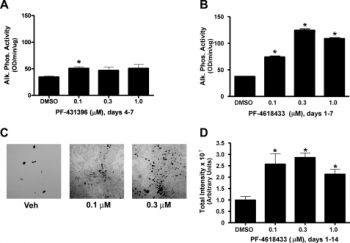This product is for research use only, not for human use. We do not sell to patients.

| Size | Price | Stock |
|---|---|---|
| 250mg | $350 | Check With Us |
| 500mg | $550 | Check With Us |
| 1g | $825 | Check With Us |
Cat #: V0661 CAS #: 717906-29-1 Purity ≥ 98%
Description: PF-431396 (PF431396) is a pyrimidine-based and selective dual inhibitor of PYK2 and FAK (focal adhesion kinase and proline-rich tyrosine kinase 2) with potential anti-osteoporotic activity. It inhibits PYK2/FAK with IC50s of 11 nM and 2 nM, respectively. PF 431396 acts by promoting osteoblast recruitment and activity, thus stimulating bone formation in ovariectomized rats. PF-431396 can be potentially used in treatment of osteoporosis.
References: J Biol Chem. 2009 May 8;284(19):13193-201; J Biol Chem. 2009 Aug 21;284(34):22865-77.
Publications Citing InvivoChem Products
Product Promise

- Physicochemical and Storage Information
- Protocol
- Related Biological Data
- Stock Solution Preparation
- Quality Control Documentation
| Molecular Weight (MW) | 506.5 |
|---|---|
| Molecular Formula | C22H21F3N6O3S |
| CAS No. | 717906-29-1 |
| Storage | -20℃ for 3 years in powder formr |
| -80℃ for 2 years in solvent | |
| Solubility In Vitro | DMSO: 100 mg/mL (197.43 mM)r |
| Water: <1 mg/mLr | |
| Ethanol: <1 mg/mL | |
| SMILES Code | CS(=O)(N(C)C1=CC=CC=C1CNC2=NC(NC3=CC4=C(NC(C4)=O)C=C3)=NC=C2C(F)(F)F)=O |
| Synonyms | PF 431396; PF431396; PF-431396; |
| Protocol | In Vitro | In vitro activity: In A20 cells, PF-431396 blocks anti-Ig- and clustering LFA-1-induced tyrosine phosphorylation of Pyk2 and FAK, and further blocks B cell spreading. PF-431396 consistently inhibits the increase in protein tyrosine phosphorylation (PY) induced by the absence of added calcium and induced by W-7 in the presence of calcium. Kinase Assay: PF-431396 is dual focal adhesion kinase (FAK) and proline-rich tyrosine kinase 2 (PYK2) inhibitor (IC50 values are 2 and 11 nM respectively), PF-431396 has a Kd value of 445 nM for BRD4. IC50 value: 2 nM (FAK); 11 nM (PYK2); 445 nM (KD for BRD4) [1] [2] Target: FAK; PYK2; BRD4 in vitro: PF-431396 is a potent and highly selective pyrimidine-based inhibitor of both Pyk2 and FAK, Consistent with the idea that the tyrosine phosphorylation of Pyk2 and FAK involves an initial autophosphorylation or transphosphorylation step, treating A20 cells with PF-431396 blocked anti-Ig-induced tyrosine phosphorylation of Pyk2 and FAK when the cells were stimulated in suspension when they were stimulated on ECM. Nanomolar affinities were also determined for PF-431396 (Kd = 445 ± 42 nM) and for the PIM inhibitor (Kd = 565 ± 63 nM). |
|---|
| Solvent volume to be added | Mass (the weight of a compound) | |||
|---|---|---|---|---|
| Mother liquor concentration | 1mg | 5mg | 10mg | 20mg |
| 1mM | 1.9743 mL | 9.8717 mL | 19.7433 mL | 39.4867 mL |
| 5mM | 0.3949 mL | 1.9743 mL | 3.9487 mL | 7.8973 mL |
| 10mM | 0.1974 mL | 0.9872 mL | 1.9743 mL | 3.9487 mL |
| 20mM | 0.0987 mL | 0.4936 mL | 0.9872 mL | 1.9743 mL |
This equation is commonly abbreviated as: C1 V1 = C2 V2
- (1) Please be sure that the solution is clear before the addition of next solvent. Dissolution methods like vortex, ultrasound or warming and heat may be used to aid dissolving.
- (2) Be sure to add the solvent(s) in order.







































